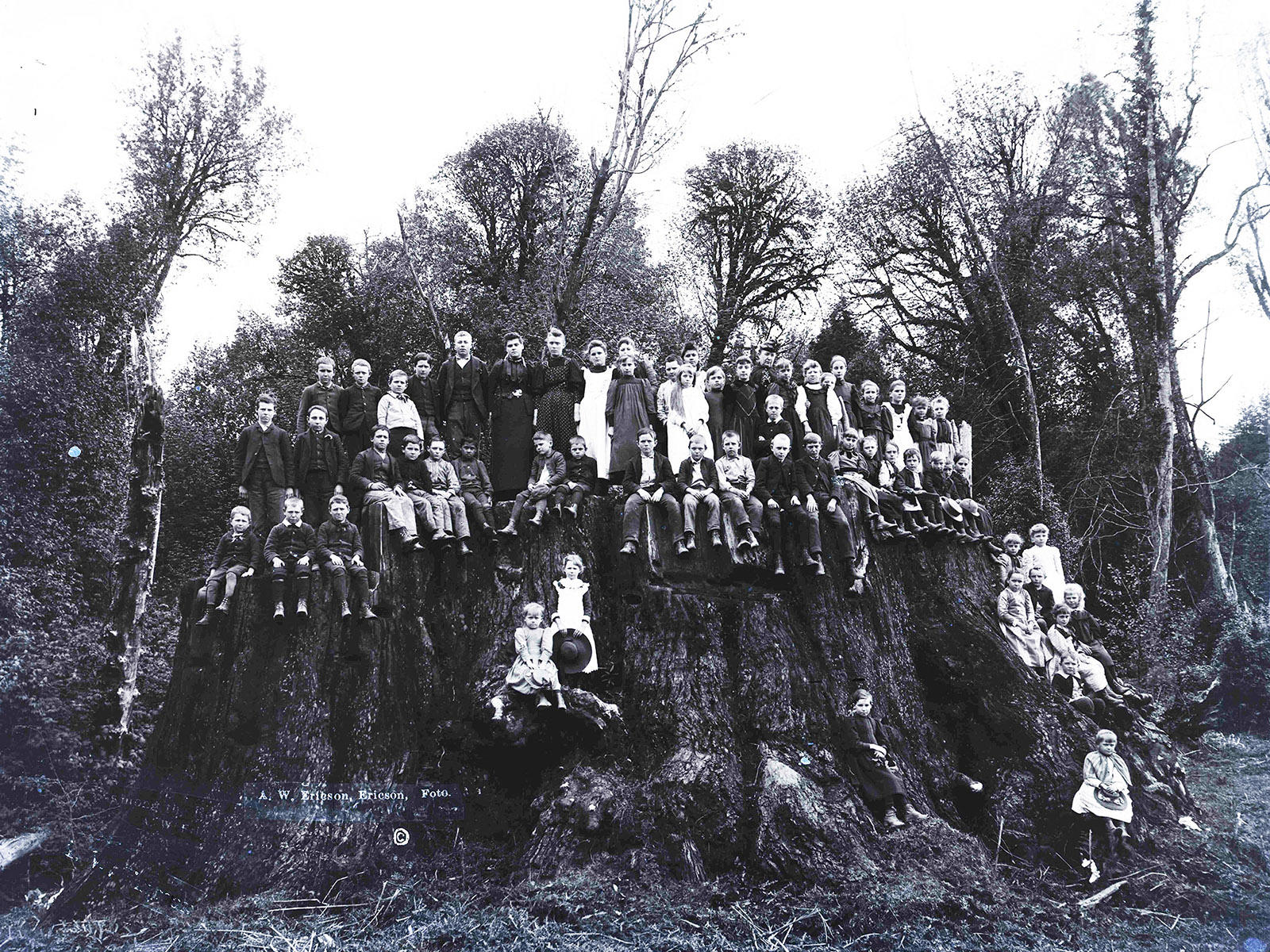
It was way too big for the average lawn, but still, it was magnificent. The giant coastal redwood tree was 35 feet across and may have stood as high as 400 feet. At that height, it was among the tallest living things on Earth when it met its saw-toothed end in the 1890s, reportedly to satisfy a rich man’s drunken bet over who could build the biggest table.
The resulting Fieldbrook stump, as it is known now, has been reborn, along with 130 other tree varieties that were the biggest and strongest of their breed. Saplings cloned from the stumps of the redwoods are taking root, thanks to an arborist whose near-death experience prompted him to start a nonprofit organization. Its mission: to reforest the world with the offspring of champion trees.
“We can rebuild old grove forests utilizing the genetics of the largest, oldest, strongest, proven-through-the-test-of-time giants,” said David Milarch, a third-generation Michigan arborist and founder of the nonprofit Archangel Ancient Tree Archive. “They will help us turn around this scourge that we face — the threat of climate change.”
The group’s most recent project, in December 2018, was to plant in a San Francisco park 75 coastal redwood saplings cloned from five different giant redwood stumps, including the Fieldbrook.
The coastal redwood
The coastal redwood, Sequoia sempervirens, is the world’s tallest tree, and the stumps of the trees Milarch and his group cloned were among the tallest of the tall. Where 200 feet is a common height and 500-800 years a common age, the parents of the cloned saplings were up to an estimated 400 feet tall and 3,000 years old.
Because of that lineage, the saplings have the chance to grow into a “super grove” of giant trees, he said.
Archangel Ancient Tree Archive, a 501(c)(3) nonprofit, works to propagate the world’s most important old-growth trees before they vanish. The archive estimates that more than 95 percent of such trees are already gone.
All plants, including your lawn, benefit the environment because they take in carbon and release oxygen. But redwood trees are the champions at it. Because of their size, redwoods perform this task, called carbon sequestration, better than any other plant on earth, according to a study published in February by forestry researchers from Washington State University and Humboldt State University.
Milarch’s team harvests the cuttings or seeds of the biggest and oldest trees they can find, and take them back to their lab in Copemish, Mich., where, depending on the species, they apply different techniques to coax them to root. They’ve cloned or grown seeds from 130 species of trees, he said.
In addition to propagating them, the nonprofit also archives the genetics of the species for future study.
“The redwoods we clone are 2,000 to 3,000 years old and no one knows how they did that,” Milarch said. “If people 300 years old were walking around the village, don’t you think science would be interested to find out why?”

Near-death experience
Milarch came to found his nonprofit in an unusual way: He died.
Twenty-five years ago, he said, he lay dying of renal failure. “I was lying in bed with total renal failure, and it’s a pretty miserable way to go,” he said. “It’s like the flu on steroids.”
He said he passed away, saw a light and followed it. And he was spoken to. He’s not sure what to call his after-life hosts. “Angels” is fine with him, though. “They told me I had to go back, that I had work to do.”
He came back to life and in six weeks recovered, a changed man. “When you come back to life, a lot of things change. The things that you thought were important, like making big piles of money, aren’t. Your awareness is heightened,” he said.
His reforestation quest began not long after — kicked off by another visit from a light.
“An angel told me to sit down with a paper and pen,” he said. “I came to the next day with the plan for Archangel Archive written out.”
Milarch’s remarkable story was chronicled in the 2012 book “The Man Who Planted Trees: A Story of Lost Groves, the Science of Trees, and a Plan to Save the Planet,” by New York Times science writer Jim Robbins.
The drunken bet
Just as remarkable is the story behind how the Fieldbrook tree, 35 feet across, became the Fieldbrook stump.
In 1890, one of the richest men in the world, William Waldorf Astor, relocated from America to England, and soon bought a magnificent historic mansion outside of London, Cliveden, and began renovations on it.
In 1897, he brought a 16-foot, 6-inch across slice of the Fieldbrook tree to Cliveden.
“Rumors at the time claimed Lord Astor had made a drunken bet that trees in America were so large that he could find one that would seat 50 people around it for dinner,” according to the National Trust, the British charity that now owns Cliveden, the Astor’s mansion. It was never made into a table and now rests in the woodlands outside the home. Instead of lords and ladies, it is occupied by cave spiders and bats, according to the National Trust.
After its cutting, the stump became something of a tourist attraction in Humboldt County, Calif. Groups of people would clamber up its rough sides and pose for photos.
“The largest living thing on Earth came down and was taken across the ocean and landed in England because of a bar bet,” Milarch said. That’s pretty pathetic, I think.”

Should you plant a redwood? Maybe …
If you’re inspired by Milarch’s example and want to plant a redwood, consider the choice carefully. Unless you give redwoods plenty of elbow room, care, and the right climate, they will be unhealthy, unsuitable or both.
The coastal redwoods have adapted to the foggy West Coast of Northern California and Oregon, taking in a lot of moisture that way, and will be thirsty without fog.
Their sheer size can make them unwelcome in a typical small back yard. According to Lawnstarter.com data, the average lawn is just 8,364 square feet — a bit shy of 1/5 of an acre. That’s tight quarters for any of the giants like Milarch’s group is planting.
Their roots are shallow but they spread horizontally, potentially harming foundations and sidewalks.
Notoriously messy trees, redwoods shed an abundance of leaves and branches. With a giant tree, a dropped branch can be a significant event. General Sherman, the world’s largest tree, lost a branch the size of a compact car during a storm in 2006. It took out a fence and crushed the walkway pavement below.
But given a friendly climate, ample room and the right care, they can be an impressive showcase addition to a home, growing several feet a year.
“You want the right tree in the right place,” Milarch said.





